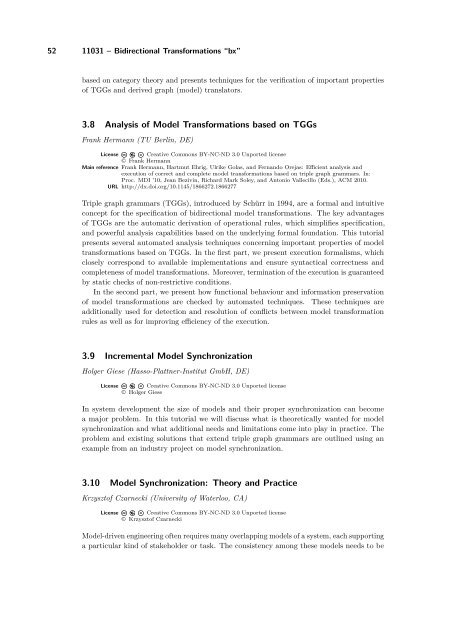Volume 1, Issue 1, January 2011 - DROPS - Schloss Dagstuhl
Volume 1, Issue 1, January 2011 - DROPS - Schloss Dagstuhl
Volume 1, Issue 1, January 2011 - DROPS - Schloss Dagstuhl
You also want an ePaper? Increase the reach of your titles
YUMPU automatically turns print PDFs into web optimized ePapers that Google loves.
52 11031 – Bidirectional Transformations “bx”<br />
based on category theory and presents techniques for the verification of important properties<br />
of TGGs and derived graph (model) translators.<br />
3.8 Analysis of Model Transformations based on TGGs<br />
Frank Hermann (TU Berlin, DE)<br />
License Creative Commons BY-NC-ND 3.0 Unported license<br />
© Frank Hermann<br />
Main reference Frank Hermann, Hartmut Ehrig, Ulrike Golas, and Fernando Orejas: Efficient analysis and<br />
execution of correct and complete model transformations based on triple graph grammars. In:<br />
Proc. MDI ’10, Jean Bezivin, Richard Mark Soley, and Antonio Vallecillo (Eds.), ACM 2010.<br />
URL http://dx.doi.org/10.1145/1866272.1866277<br />
Triple graph grammars (TGGs), introduced by Schürr in 1994, are a formal and intuitive<br />
concept for the specification of bidirectional model transformations. The key advantages<br />
of TGGs are the automatic derivation of operational rules, which simplifies specification,<br />
and powerful analysis capabilities based on the underlying formal foundation. This tutorial<br />
presents several automated analysis techniques concerning important properties of model<br />
transformations based on TGGs. In the first part, we present execution formalisms, which<br />
closely correspond to available implementations and ensure syntactical correctness and<br />
completeness of model transformations. Moreover, termination of the execution is guaranteed<br />
by static checks of non-restrictive conditions.<br />
In the second part, we present how functional behaviour and information preservation<br />
of model transformations are checked by automated techniques. These techniques are<br />
additionally used for detection and resolution of conflicts between model transformation<br />
rules as well as for improving efficiency of the execution.<br />
3.9 Incremental Model Synchronization<br />
Holger Giese (Hasso-Plattner-Institut GmbH, DE)<br />
License Creative Commons BY-NC-ND 3.0 Unported license<br />
© Holger Giese<br />
In system development the size of models and their proper synchronization can become<br />
a major problem. In this tutorial we will discuss what is theoretically wanted for model<br />
synchronization and what additional needs and limitations come into play in practice. The<br />
problem and existing solutions that extend triple graph grammars are outlined using an<br />
example from an industry project on model synchronization.<br />
3.10 Model Synchronization: Theory and Practice<br />
Krzysztof Czarnecki (University of Waterloo, CA)<br />
License Creative Commons BY-NC-ND 3.0 Unported license<br />
© Krzysztof Czarnecki<br />
Model-driven engineering often requires many overlapping models of a system, each supporting<br />
a particular kind of stakeholder or task. The consistency among these models needs to be













